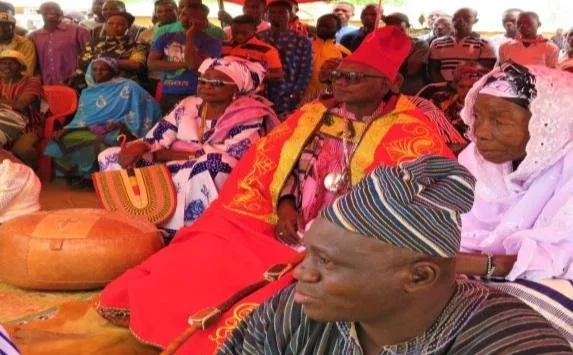Who Controls Stool Land Royalties? Understanding Chieftaincy, Gazetting, and Allodial Title in Ghana

In Ghana, land ownership and traditional leadership go hand in hand. But when it comes to Stool land, chieftaincy status, and government royalties, things can get complicated — especially if you’re a divisional chief, not yet gazette, or have joined another Traditional Council temporarily.
This post breaks down these complexities and answers a critical question:
If a divisional chief or not yet gazette as a paramount chief, and his land is under another Traditional Council, who receives the royalties from my land — and who holds the allodia title?
The Complex Terrain: Customary Land, Chieftaincy, and Royalties
Ghana’s land and chieftaincy system is governed by both customary law and state law. Three key elements matter in this conversation:
- Customary land ownership (especially Stool land)
- Chieftaincy recognition (gazetting and hierarchy)
- Government royalty distribution (via the Office of the Administrator of Stool Lands)
Your Possible Situation:
Let’s say:
- If a chief or land custodian over a specific area.
- If a chief is not yet gazetted as a paramount chief.
- If a chief have temporarily joined another Traditional Council (TC) because he don’t yet have your own.
- The land is his own ancestral Stool land, not originally under the paramount chief he’ve joined.
Key Legal and Traditional Realities (In Ghana)
- Gazetting Confirms Legal Recognition
- Until a Chief is gazetted as a paramount chief, the government does not officially recognize his authority over a Traditional Area.
- This means:
- He cannot form his own Traditional Council.
- He cannot receive royalties directly from the government.
- His lands will be administratively treated as part of the Traditional Council he’ve joined.
- Joining Another Traditional Council Transfers Administrative Custody
- By affiliating his land with another Traditional Council, the paramount chief of that Council becomes the recognized authority — even over his own land.
- As a result, royalties from his land will go to that paramount chief until he gain full recognition.
- Royalties Follow Official Records, Not Customary Claims
The Office of the Administrator of Stool Lands (OASL) distributes royalties based on:
- Gazetted records
- Traditional Council jurisdictions
- Land registration
If his land is listed under another TC, that paramount chief receives the royalties — regardless of his customary claim.
What If You’re a Gazetted Divisional Chief?
This adds another layer. If a chief is a gazetted divisional chief:
- He has legal recognition of his chieftaincy, but he is still under a paramount chief.
- He belong to a Traditional Council, but he cannot form his own or receive royalties directly.
- The paramount chief’s Stool holds the authority and receives royalties for his land.
Even if the land is part of his division, He is not the administrative head of the area, and OASL will not pay Him directly.
He can only access royalties if:
- The paramount chief shares a portion with Him (customary arrangement), or
- He petition successfully to become a paramount chief, form hhis own TC, and reclaim land jurisdiction.
Who Holds the allodial Title?
This is critical. The allodial title is the highest form of land ownership under customary law.
Who Holds It?
| Land Type | Allodial Title Holder |
| Stool Land | The Stool (chief) |
| Family Land | Family head (Abusuapanyin) |
| State Land | The Republic (via Lands Commission) |
| Private Land | A lawfully documented individual/entity |
In this case:
- As a divisional chief, his Stool holds the allodial title over his division — but it is subordinate to the paramount chief’s Stool.
- If he is not gazetted, or his land is listed under another TC, the recognized paramount chief is treated as holding the allodial title for administrative purposes.
To regain or assert full allodial control, He must become a gazetted paramount chief, form His own TC, and claim legal recognition of his jurisdiction.
When someone says that “Someone lands are on his Stool land,” it does not automatically mean they are the ancestral or allodial owner of the land. Here’s why:
It could mean:
- They are the recognized custodian of the land under customary or administrative law.
- They receive royalties from the OASL — meaning the land is currently recorded under their Stool.
- They exercise jurisdiction or traditional authority over that area.
But it doesn’t necessarily mean:
- They are the original ancestral owner of the land.
- Their Stool has always held allodial title over the land.
- There is no competing claim from another family, chief, or historical landowner.
Why?
- Stool land jurisdiction can shift due to migrations, war, colonial decisions, or modern administrative restructuring.
- OASL pays based on gazetted authority, not necessarily on ancestral ownership.
- The real ancestral custodians may no longer control the land if they haven’t been gazetted or have lost authority over time.
What You Can Do
Here’s how to navigate and eventually regain control over your land and royalties:
- Pursue Gazetting
Begin or complete the process to be gazetted as a paramount chief, which is a prerequisite for full recognition.
- Establish Your Traditional Council
Once gazetted, apply to the House of Chiefs to form your own Traditional Council.
- Notify Key Institutions
Send formal letters to:
- OASL
- Regional House of Chiefs
- Lands Commission
Request that the administrative jurisdiction and royalty payments be reassigned to your Stool.
- Negotiate or Litigate If Necessary
- Try to negotiate a share of royalties with the current Traditional Council.
- If you believe your land was wrongly listed under another TC, you may petition for reclassification or even take legal action.
Final Summary
| Chief Type | Traditional Council? | Direct Royalties? | Alodial Title Status |
| Not Gazetted | No | No | Not officially recognized |
| Gazetted Divisional Chief | Member of TC | No (unless shared) | Subordinate to paramount chief |
| Gazetted Paramount Chief | Own TC | Yes | Full alodial recognition |
If you’re not yet gazetted, or a divisional chief under another TC, the paramount chief will receive the royalties from your land. To change this, you need to gain recognition, form your own council, and reclaim administrative control over your land and its royalties.
Understanding the Land Affiliation and Traditional Authority in Ghana
- Joining a Traditional Council Is an Administrative Affiliation — Not a Transfer of Ownership
A divisional chief without a Traditional Council must join an existing TC to perform functions like:
- Representing chieftaincy matters in the Regional House of Chiefs
- Accessing stool land royalties (via OASL)
- 2. Simply joining a council does not transfer alodial title or customary custodianship.
- Can a Chief Leave Traditional Council and Join Another?
Yes — in principle, he can, but there are important conditions and implications.
Legally, a divisional chief can:
- Apply to disaffiliate from one Traditional Council, and
- Join another TC, especially if:
- The new TC shares closer cultural or tribal roots.
- The current TC does not represent his people’s traditions.
But:
- He would need clear justification and acceptance from the new TC.
- The House of Chiefs and Regional Chieftaincy Secretariat must approve the realignment.
- Should He Join a Distant Council Like?
That depends on the goal:
| Reason | Consideration |
| To join a tribally or culturally similar council | Could make sense to join even if geographically distant. |
| If it’s purely to escape TC influence | It may weaken his influence locally or raise challenges. |
| If the new TC has no historical, cultural or geographical connection | House of Chiefs may reject the affiliation request. |
So while it is legally possible, it must be justified, and the new TC must accept him.



